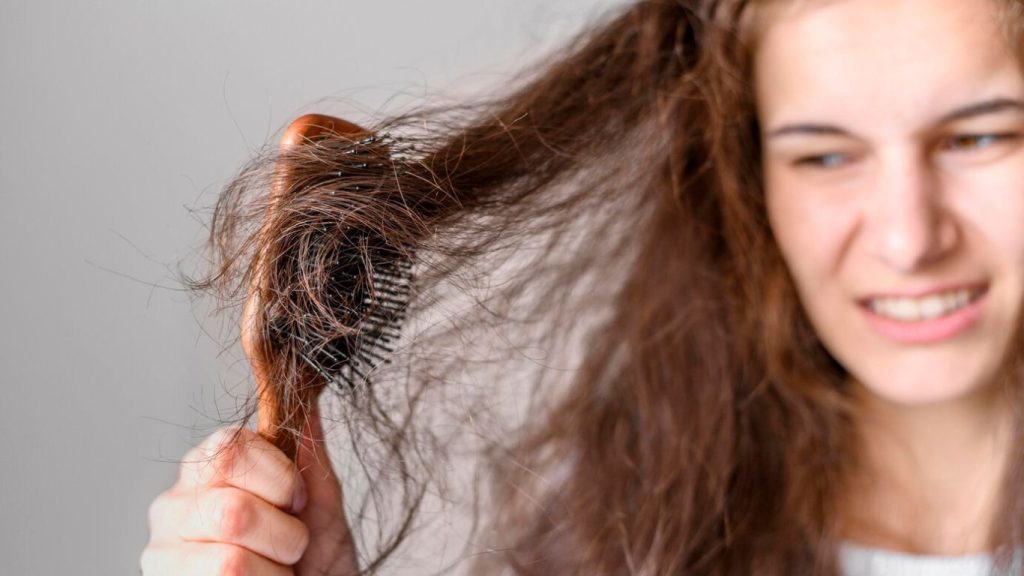Introduction
Our hair is often referred to as our crowning glory, and for good reason. Healthy, lustrous locks can boost our confidence and make us feel fantastic. But how do you determine if your hair is genuinely healthy? Is it all about appearance, or are there subtle signs that indicate the true condition of your mane? In this comprehensive guide, I’ll walk you through the various factors that can help you assess the health of your hair. From its texture and shine to its resilience and manageability, we’ll explore the signs that your hair is in great shape and what you can do to maintain its vitality. Let’s dive into the world of healthy hair!

Understanding Hair Anatomy
The Structure of Hair: Before we delve into the signs of healthy hair, it’s essential to understand the basic structure of hair, from the root to the tip.
The Hair Growth Cycle: Learn about the different stages of the hair growth cycle and how they impact the overall health and appearance of your hair.
The Visual Indicators of Healthy Hair
- Shine and Luster: Discover how the shine and luster of your hair can be a strong indicator of its health and vitality.
- Smooth Texture: Smooth, touchable hair is a hallmark of good hair health. We’ll explore how to assess the texture of your hair to determine its condition.
Elasticity and Strength
Elasticity
Elasticity is a key factor in determining how resilient your hair is to damage. Learn how to test your hair’s elasticity and what it means for its health.
Strength and Breakage
Find out how to assess the strength of your hair and recognize signs of excessive breakage, which can indicate underlying issues.

Scalp Health
The Role of the Scalp
A healthy scalp is the foundation of healthy hair. We’ll discuss the signs of a well-nourished scalp and how it contributes to vibrant hair.
Common Scalp Issues
Explore common scalp problems like dandruff, itching, and dryness, and how they can affect the health and appearance of your hair.
Manageability and Styling
Ease of Styling
Hair that is easy to style and manage is often a sign of good health. Learn how to assess your hair’s manageability.
Heat and Styling Damage
Excessive heat and styling can damage your hair over time. We’ll discuss how to minimize damage and protect your hair while styling.
Diet and Nutrition
The Role of Nutrition
Your diet plays a significant role in the health of your hair. Discover how specific nutrients can promote hair health and growth.
Signs of Nutritional Deficiency
We’ll explore how signs of nutritional deficiencies, such as brittle hair or hair loss, can indicate the need for dietary adjustments.
Lifestyle and Hair Health
Stress and Hair
Stress can impact your hair’s condition. We’ll discuss how managing stress can contribute to healthier locks.
Environmental Factors
External factors like exposure to the sun, pollution, and harsh weather can affect your hair. Learn how to protect your hair from environmental damage.
Hair Care Practices
Choosing the Right Hair Care Products
Selecting the appropriate hair care products for your hair type is crucial. We’ll provide guidance on how to choose the right products.
Overcoming Bad Hair Habits
Identify common bad hair habits like over-washing or excessive heat styling, and learn how to break them for healthier hair.
When to Seek Professional Help
Signs of Hair Problems
Discover when certain signs or symptoms indicate the need for professional consultation with a dermatologist or trichologist.
Hair and Health Conditions
We’ll discuss how underlying health conditions can manifest in hair problems and when it’s essential to address these issues.
Read Also : How to Know Acupuncture is Working

Conclusion – Nurturing Your Healthy Hair
In the concluding chapter, we’ll summarize the key indicators of healthy hair and provide practical tips for maintaining and nurturing your locks. Remember that achieving and maintaining healthy hair is an ongoing journey that involves a combination of good practices, nutrition, and care. Embrace the signs of healthy hair, and continue to love and appreciate your crowning glory!
Frequently Ask Questions
Take a strand of your hair and gently pull. If it breaks immediately, your hair might need more moisture. If it stretches then breaks, you may have too much moisture and need protein.
About every 6-8 weeks for shorter hair, and every 12 weeks for longer locks. Ignore at your own peril.
Not necessarily. Your hair might be just as happy with a drugstore brand as with a high-end product.
You bet your sweet avocado it does! A balanced diet rich in proteins, vitamins, and minerals can help keep your hair looking like it belongs in a shampoo commercial.
Losing 50-100 strands a day is normal. If you start to see significant thinning or bald patches, consult a healthcare provider.
It’s how well your hair absorbs and retains moisture. Think of it like your relationship status with water: Low porosity is “It’s complicated,” high porosity is “In an open relationship,” and medium porosity is “Married.”
Once they’re split, they’re done. It’s like trying to un-toast toast. The only real cure is a trim.
